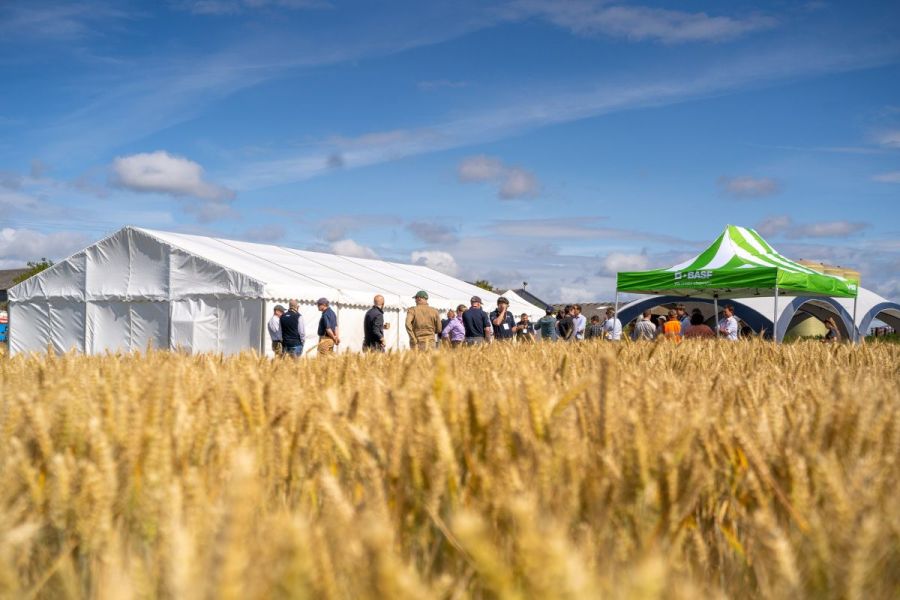A five-year sustainability project continues in its plight to educate agricultural policy makers and gain traction within industry. CPM returns to Project Fortress to learn if the wheels are still in motion.
“We can’t reverse climate change quickly, but a farmer can change their soils relatively quickly.”
By Janine Adamson
The year 2030 might be perceived as a long way away, but in reality, it’s just five growing seasons. And during that time UK agriculture has to adapt and achieve so much.
Some could view that as a daunting message from Joel Johnson, BASF’s recently appointed business director for its agricultural solutions operation in the UK and Ireland. However, he’s confident that by actively collaborating, the company will achieve it’s 2030 sustainability targets – part of its commitment to the Paris Climate Agreement.
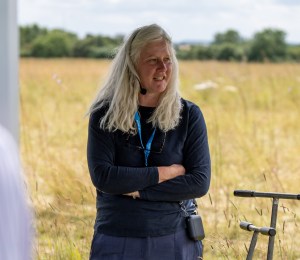
Because fortress field is sloping, much of the quality topsoil content had washed down, says Jenni Dungait.
The reason for his optimism? BASF has a powerful tool in its armoury – Project Fortress, one of two strategic partnerships with commercial farms.
Based at The Grange in Northamptonshire, Project Fortress aims to showcase how to deliver a balanced approach to sustainable farming and soil health by focusing on improved management of rotations, cultivations and inputs. It was established in 2021 in response to growing pressures on land use and the success of BASF’s original biodiversity platform, Rawcliffe Bridge in East Yorkshire.
Essentially, Project Fortress is a five-year experiment developed by BASF’s Mike Green and supported by farmers Andrew and William Pitt, who’ve been working with the company since 2009. Centred around ‘fortress field’, which had previously reached a yield plateau, the research hopes to deliver increased biodiversity while respecting the requirements of a commercial business.
It’s this connection to ‘real farming’ which BASF’s Rob Gladwin believes makes the project an ideal place to host Westminster. “We started Project Fortress to try to educate policy makers, and post-Brexit, this is even more important because we should be able to shape our future,” he comments, during an open day at the site.
As a result, William says he’s beginning to see the fruits of their labour. “We’re passionate about farming with the environment in mind but no one would listen to farmers in Northamptonshire.
“Through this partnership, we now have a step on the ladder and a chance to influence not only what happens on our farm, but all farms. We can’t reverse climate change quickly, but a farmer can change their soils relatively quickly.”
Thanks to Project Fortress presenting an opportunity to assess the impact of climate change on a daily basis, BASF believes it’s starting to make inroads with its effort to educate agricultural policy decision makers. Rob says he’s heartened the company is trusted as a thought leader in sustainable farming.
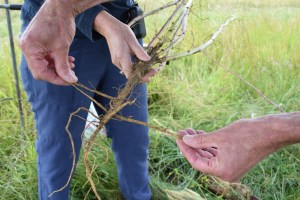
Sweet clover is used in the two-year cover crop mix which has established a large rooting system, notably an extensive tap root.
But what is it that’s successfully captured the attention of ministers and alike? For one, it’s providing metrics which tangibly demonstrate how different rotations impact soil health. This is based around measuring bulk density and soil organic carbon (SOC) across fortress field.
Four treatments are taking place at the Hanslope clay site – a four-year herbal ley with mob grazing, a one-year ‘supercharger’ cover crop, a two-year supercharger cover crop, and finally, business-as-usual arable cropping. When operating in its previous guise as a traditional arable rotation, it was no-till, resulting in considerable hidden subsoil compaction.
Independent soil scientist, Professor Jenni Dungait, says because the field is sloping, much of the quality topsoil content had washed down, therefore it was important to find ways to reinvigorate while preventing run-off. “The root mass from the grass in the herbal ley has significantly increased stored carbon whereas the chicory roots have penetrated through the compaction,” she says.
However, she admits that because heavy soils often require structural help beyond what plants can offer, in this instance, she’d also recommend subsoiling.
Noting Jenni’s advice, William did so in 2021. He comments he’s impressed with the added benefits of the herbal ley from a sheep health perspective. “It makes no money as an arable farmer, but as a sheep farmer, it does. The herbs in the mix have natural worming properties.
“We’ve also seen effective blackgrass control – no one is quite sure why, but the field was awash with the weed before and now it isn’t,” he says.
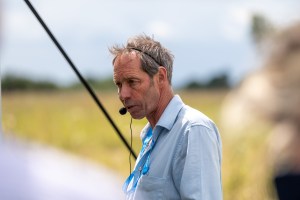
William Pitt says his goal is to understand how to make improvements deeper within the soil and break up the historical layer of compaction.
Following this year’s assessments, Jenni is most impressed with the rooting of the two-year supercharger cover crop, notably, the biennial sweet clover (yellow blossom). To demonstrate, she digs up a plant to share with visitors at the open day, highlighting the extensive tap root.
“What a phenomenal engineering tool. The clover has sent out horizontal roots where it’s encountered soil compaction, but the tap root has continued to grow down. It’s acting as a deep pathway and we’ve no idea where it ends,” she says.
The cover crop mix otherwise includes vetches, black oats and tillage radish, all selected for their rooting ability.
Comparing the root structure of a blackgrass plant with wheat also proves a discussion point. “The blackgrass is performing better than the cash crop within the same space. Could breeders extract that rooting gene to help develop future wheat varieties?” asks Jenni.
Being able to penetrate deeper is important because measurements suggest fortress field has almost reached its potential in terms of soil organic matter (SOM) within the topsoil (7%). For the subsoil, this currently stands at 3-4%.
“Our goal is understanding how to make improvements deeper within the soil and break up the historical layer of compaction,” says William. “If we can achieve that within five years it’d be amazing.”
As a means of supporting the feeding, breeding and over-wintering of biodiversity, 8m-wide ‘agrifloristry’ strips intersperse the trial treatments. To measure the impact, BASF is working with experts from the Game and Wildlife Conservation Trust.
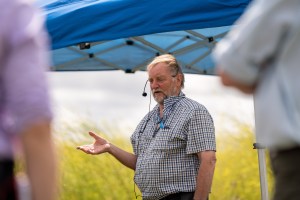
Marek Nowakowski recommends taking a relaxed approach to hedgerow management to help address the early season hunger gap experienced by insects.
Ecologist Dr Lucy Capstick explains this involves sampling insects using two methods – installing pitfall traps and using a D-VAC machine. The results so far are in favour of the Fortress approach.
“We’ve found greater abundance of beneficial insects within established habitats such as the agrifloristry strips. Wildflower pollen and nectar mixes seem to really support parasitic wasps,” she says.
Lucy stresses the impact of tillage on insect numbers at Project Fortress, particularly ploughing. “You can find a lot more invertebrates when direct drilling because ploughing ultimately destroys habitats by removing leaf litter as well as physically killing the insects.”
She also explains that from an ecological perspective, the picture remains unclear when it comes to the full impact of climate change. “We do know that dry conditions, such as the drought experienced in 2020, can have a negative effect on beetle larvae numbers because it affects their emergence. Conversely, water-logging can negatively impact other types of insects.”
Whereas many techniques are available to boost biodiversity, Project Fortress simplifies them into three main categories, all of which can be seen in action at the farm – habitat creation, feeding farmland birds and planting flowers.
According to independent wildlife and crop advisor, Marek Nowakowski, a key factor in the success of this is understanding exactly where to create habitats and how far to space them apart. “It’s not all about honeybees, the genuinely useful pollinators are in fact, solitary bees. So it’s knowing where to give them a petrol station to fuel up.”
Another recommendation from the experts is to take a relaxed approach to hedgerow management which addresses the early season hunger gap experienced by insects. “Stitching diversity back into the farm in this way creates a tapestry of opportunity for wildlife,” says Marek.
Encouragingly, the numbers indicate this approach is working – in the last 10 years, The Grange has increased bird numbers from slightly above the farmland bird index to off the scale. “Remember this is all within a commercial environment,” says William. “We’ve achieved it by making actions such as supplementary feeding and no longer using insecticides,” he says.
Acknowledging this is just one soil type at one site in Northamptonshire, BASF invited Hannah Darby to speak at the Project Fortress open day to provide an alternative perspective on soil health and managing peat.
Farming a mix of black fen and heavy clay soils across 310ha in Sawtry, Cambridgeshire, Hannah says she was motivated to take action after seeing the degradation of the fen in front of her eyes. “The topsoil was being wind eroded into the ditches, while in one year, the farm had used the plough across everything to bury blackgrass, which resulted in lower yields.
“We took the decision to go no-till as a means of keeping the topsoil consolidated and retained,” she explains. “We’re exiting crops such as potatoes and sugar beet and starting to plant cover crops to mitigate the wind erosion.”
Hannah’s also planted 6m-wide nectar flower margins around most field edges, but following her day at Project Fortress, is considering moving them. “The edges can be our most productive areas of the land so perhaps I ought to reconsider and move them into the middle,” she concludes.
This article was taken from the latest issue of CPM. For more articles like this, subscribe here.
Sign up for Crop Production Magazine’s FREE e-newsletter here.

